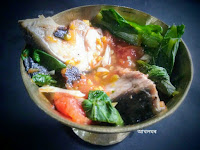Before you know what is Assamese cuisine, let me tell you a little bit about Assam and the various communities of Assam.
Assam is a state in the Northeast part of India. It is the heart among the 8 Northeastern states of India. Assam is well known for its wildlife and tea plantation. Assam is famous for one horned rhino, the Maa Kamakhya temple and the mighty river Brahmaputra. Assamese Society is a multi ethnic, multi linguistic and multi religious society. In Assam there are many tribes living, having their own language, culture, customs, traditions and of course own cuisines. So Assamese cuisine is the cuisine of Assam and its different multi ethnic communities and tribes living in different parts of Assam.
Assamese people are well know for their excellent hospitality. Rice is the main food and fish is an everyday business. A traditional Assamese meal begin with khar and at the end of the meal tamul paan is served.
Assamese cuisine can be described in the following headings:
Rice:
 |
| Photo credit : Sampurna |
Rice is the main ingredient of Assamese cuisine. Some particular rice are grown in Assam alone such as sticky rice (bora chawl), aromatic rice (joha chawl) etc. Rice is served in lunch and dinner. In everyday cooking, Assamese people likes to eat plain rice or boiled rice. Boiled rice is served basically with sour fish curries which are Assamese peoples' favourite dish. Rice is also served with lentils or different dals and vegetable found in this part of northeast India such as feddlehead ferns, colocasia, spinach, water spinach, mustard plant, mustard green, amaranth, green amaranth, white goosefoot etc. Meat is also served with rice. Assamese people usually eat chicken, mutton, duck meat, pork etc.
Almost all Assamese specially in rural areas like to have rice in both lunch and dinner.
Khar:
 |
| Kolkhar |
Khar is an alkali prepared from sun dried skin of some varieties of banana. It is prepared by filtering the water from the burn ashes of the skin of the banana. Therefore it is also called kolkhar (kol means banana). It is preserved in bottles and can be used for months. It sounds bizarre but Assamese people are using khar as a cooking ingredient since time immemorial when salt was not discovered. It is believed that khar cleanses the stomach.
A traditional Assamese meal begin with khar recipe. A khar recipe can be prepared with raw papaya, bottle gourd, dry Jasmin flower, doron bon xaak, fish head etc. In a khar recipe khar is the key ingredient. One or two tablespoons is enough to prepare khar recipe. Khar can also be consumed as raw by just adding chopped garlic, few drops of mustard oil and salt.
Pitika:
 |
| Pitika |
Pitika means mashed. Pitika is the signature recipe of Assamese cuisine. Assamese people love to eat vegetables by mashing them with chopped onion, chilli and mustard oil after boiling or smoking/grilling them. Its taste is very pure. Sometimes raw onion is used and sometimes fried onion is used in these recepies. In Assamese cuisine mustard oil is used for all purposes as it can also be consumed as raw. Pickled chilli or pickled bhut jolokia adds more taste to these dishes. These pitika recipes are great appetizer and generally takes very less time to prepare.
Greens and vegetables:
Different herbs and medicinal plants and leafy vegetables are available in Assam such an fiddlehead ferns, skunk vine, colocasia leaves, modhuxulung etc. These herbs, greens and vegetables are generally eaten by simple frying, adding into different lentils, fish or meat. Green leafy vegetables are called xaak which are important part of Assamese cuisine. Greens and vegetables are grown and some found in wild.
Fish dishes:
 |
| P. C. Sampurna |
Sour fish curries (masor tenga) are Assamese people's all time favorite. An Assamese can eat sour fish curry everyday. In other words an Assamese can eat fish in every dinner or lunch.The mighty river Braumaputra and its sub-rivers are wondefull sources of some good river fish. There are many indigenous fish found in Assam. Assamese love to eat fish by making sour fish curries or by grilling on open fire and making pitika and also by cooking in banana or turmeric leaves. Each and every part of a fish is cooked and liked by Assamese people including fish head and of course intestine parts. Masor patu or fish intestine is cooked in many different ways and liked by the people of Assam.
Meat dishes:
Tea:
The Tea production and consumption was introduced in Assam by the British during the British regime in India. There are about 765 tea estates in Assam and about one lakh small tea gardens all over Assam. Most of Assamese people wake up in the morning and the very first thing they do is to sip a delicious cup of tea. It's a common practice in many household in Assam. Drinking tea in cups is a modern practice but Assamese serve tea in bell metal bowls.
Pitha & Jolpan:
Pitha are sweets and savourys made during Bihu festivals with sticky rice, coconut, black sesame and jaggery.
Jolpan are type of snacks, ofen served as breakfat. Jolpan are also served to guests and during Bihu festivals.
Tamul paan:
 |
| Tamul paan served in Bota |
Tamul is areca nut and paan is betal leaf. Tamul pan is an integral part of Assamese society. Tamul pan is served as a pair with some lime (sun). Areca nut is first peeled and then cut into pieces. Betel leaf is also cut into pieces and then served with pieces of areca nuts. Tamul paan is offered whenever a guest visits in a bell metal utensil called Bota as a mark of honour. Tamul paan is more often served at the end of an Assamese meal for just as a refreshment.

Comments
Post a Comment